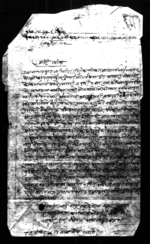A report-cum-petition from Kājīlāla Karmācāryya describing problems in organizing the Vīskāṭa procession festival of Tripurasundarī in Bhaktapur (VS 1984)
ID: K_0199_0028
Edited and
translated by Ramhari Timalsina
in collaboration with
Yogesh Budathoki
Created: 2021-06-14;
Last modified: 2022-11-30
For the metadata of the document, click here
The accompanying edition, translation/synopsis and/or commentary are available under the terms of the Creative Commons Attribution-ShareAlike 4.0 International License
Abstract
This is a report-cum-petition (jāherī darkhāsta) submitted by the priest Kājīlāla Karmācāryya to an unnamed authority, probably the prime minister, through the Guṭhī Bandobasta Aḍḍā. In it he describes the problems that arose in the year VS 1984 (1928 CE) while organizing the Vīskāṭa procession festival of Tripurasundarī in Bhaktapur and seeks authority to address them.Diplomatic edition
[1r]
1श्री 1श्री५सगुजाअडा[?]2मा 1[unknown seal]
2मोजींकामालहस्तेगरील्याईसोपर्वचलाउनभादगाउवीद्यापीठ्
3कोकर्माचार्य्यमध्येपुजाहारी२नकी१वाटपुजाकांचलाउनपर्नेमा
4पोरसालसम्मचलीआयाकोयोसालकोसोवीस्काट्पर्वचलाउना
5लाईसावीक्वमोजींभंनगये़माआउछुभनीजवाफदीपठायेकोले
6जोरजांगर्नपर्नेगरीराषेकोमापुजासामाराषनेनकीटायेंमानआ
7उदाफेरीगैघरैपीछेभंदालगत्मायेहीमानीस्भंनेकीतांनभये़को
8आउनालाईपनीहामीहरुकानाईकेजोगवीरजगत्वहादुरदुर्गाचरं
9स्मेतलेहनुकीदीये़कोलेहामीहरुआउदैनजेसोकैगरभनीआ
10षीरटायंमातेसोजवाफदिये़कोहुनालेकांअडकाउगर्ननहुनेहु
11दाअर्कैवाटकांचलाईसर्कारमाजाहेरगरेकाछुअवआयें़दादेषी
12लाईतेस्तोहुननपाउनेगरीवंदोवस्तगरीदीनुभंन्येरसोसाललेषीया
13वमोजींगरीगराये़मानीजहरुलाईअैनवमोजींगरीदीनुभंनेवेहो
14राकोरअववाकीमसांतकाअघिल्लादींदेषीवीसरजंकादींसम्म
15पुजागर्नेरपुजासराजाम्वनाउनेभोजषानेष्वाउनेकांलाईसावी
16कवमोजींवीद्यापीठकाकर्माचार्यहरुमध्येदीछ्याभये़कामानीस
17वाटलेषीय़ावमोजींपुजाहाराकांगर्नेमानीस्२रनकींवसीपुजास
18राजाम्वनाउनेस्वास्नीमानीस्१स्मेतअडैवाटजनहीधनमानु
19गरीसोदेवताकोपुजापर्वचलाउनलाउनदीनुभंन्येप्रमांगीगरि
20पाउप्रभुजोमर्जी¯¯¯ ¯¯¯ ¯¯¯ ¯¯¯ ¯¯¯ ¯¯¯ ¯¯¯
21ईतसदाभादगाउतुलाछेतोलवस्न्यापुजाहा
22रीकाजीलालकर्माचार्य्यलेजाहेरीलेषीश्री
23५सर्कारगुठीवंदोवस्तअडामार्फतचढाञाँ¯¯¯ ¯¯¯ ¯¯¯
24ईतीसंम्वत्१९८४सालचैत्र२७गतेरोज¯¯¯ ¯¯¯ ¯¯¯1[unknown seal]
Translation
In the gu. jā. aḍā1 of Śrī 5 Sarkāra
Report-cum-petition (jāherī darkhāsta)
Uprānta. In order for the Vīskāṭa jātrā festival of Tripurasundarī in Bhādagāu to be conducted, 2 priests [from] among the Karmācāryyas of the Vīdyāpīṭha in Bhādagāu and 1 nakī̃2 are supposed to perform the worship duties, having brought by hand the [necessary] materials as listed in the record (lagata). The worship had been running [fine] until last year, but this year, when [the nakī̃] was invited as usual to [help] conduct the Vīskāṭa festival, [she at first] replied that she would come, so that the necessary arrangements were made. [This] nakī̃, who is responsible for preparing the worship materials, did not come in time, however. Therefore, [we] visited again each house [of the ṭola] to call [a nakī̃ who would be ready to handle the task], but in the end they [all] replied: "In the record (lagata) no particular person is specified [for the task], and since our headmen (nāikes)—Jogavīra, Jagatbahādura and Durgācaraṇa— threatened to make us not come, we won’t come. You can do whatever you like.” Therefore, [I have had] the tasks [done] by someone else so that they are not impeded, and have reported [all this] to the government. I make petition to have an authorization letter (pramāṅgī) issued stating arrangements be made so that such [misconduct] will not happen from now on; if in a certain year arrangements are made in accordance with what has been written down, [the priests and their assistants] shall be provided with the facilities mentioned in the Ain; for the accomplishment of the worship tasks, the preparation of worship materials, and the arrangement of feasts during the days starting from the day preceding the final day of the month to the closing day [of the Vīskāṭa procession] kindly [let us] directly appoint 3 2 persons through the [Guṭhī Bandobasta] Aḍḍā to perform the tasks of the priests, [selected] from among the initiated Karmācāryas of the Vīdyāpīṭha, a nakī̃ and 1 woman who prepares the worship materials and have them conduct the worship and festival of the deity. Lord, your wish is my command.
From here, I Kājīlāla Karmācāryya, an ever [faithful], resident of Tulācheṭola in Bhādagāu, have written [this] report and submitted it through the Guṭhī Bandobasta Aḍḍā of Śrī 5 Sarkāra.
The 27th day of Caitra in the [Vikrama] era year 1984 (1928 CE).
Commentary
Two years after this document was written, Bikulāla Karmācārjye submitted a petition (K_0177_0041) to the Guṭhī Bandobasta Aḍḍā complaining of Kājīlāla Karmācārjye’s work relating to the Bisket jātrā and the Tripurasundarī temple of Bhaktapur, along with a request that the latter’s work and emolument be transferred to him.
The Vīskeṭa (or Bīskā) jātrā, which lasts for nine days, starting four days before New Year’s Day according to the Vikrama Saṃvat calendar and ending on the fifth day of the new year, is celebrated by the locals of Bhaktapur. Nepālikabhūpavaṃśāvalī 19.1(see Bajracharya and Michaels 2016: 91) states that Jagajjyoti Malla (r. 1614–1637) inaugurated this festival. The festival starts on Taumādhī Square after Bhairava and Bhadrakālī are placed into their ceremonial chariots, which were assembled near the Nyatapola temple approximately one month earlier. A tug-of-war centred on the chariot is played by inhabitants of each of the town’s two sections, and whichever side wins gets to take the chariot to their part of town immediately, while the other side has to wait their turn to do so. The chariot is eventually pulled down to Gāhiti, where it is kept for two days, and then pulled further down to Lyasinkhel on the eve of the New Year. A pole approximately 25 metres long (yaḥsĩ) is erected at the ritual ground. The moment the pole stands upright, the freestanding iconic representations of the city’s eighteen powerful deities, including Tripurasundarī, are readied for departure on the first floor of their god-houses and taken outside to palanquins. The whole jātrā down to single events are explained as Tantric symbolic acts taking the form of a drama performed by gods, the king and his people. For more information about the jātrā, see Levy 1992: 463-500 and Gutschow 2017: 122. It is interesting to note that the descriptions provided by Levy and Gutschow say nothing about the goddess Tripurasundarī’s relevance to the Bisket jātrā, whereas this document clearly states that the jātrā is in honour of her.

